Introduction
The effective brand positioning is crucial for success. It is the key to standing out from the crowd, capturing the attention of your target audience, and ultimately, gaining a competitive edge. Fortunately, there is a game-changing tool at your disposal – transit media. In this article, we will explore the world of transit media and its transformative power in elevating your brand positioning to new heights.
Understanding Transit Media
Definition of Transit Media
Transit media refers to advertising channels that effectively utilize public transportation platforms to capture the attention of a diverse audience. It encompasses various forms of communication, including but not limited to billboards, cabs, digital screens, buses and metros.


The Evolution of Transit Advertising
Transit advertising is not a new concept. Transit advertising emerged as an established practice in the 1920s for brand positioning. Streetcar and bus companies began placing advertisements inside and outside their vehicles. These early ads often featured hand-drawn images and catchy slogans.
Transit advertising grew during World War II. Companies used travel ads to promote wartime efforts such as buying war cards and stocking up. These ads not only increased awareness but also helped the morale of the country.
It has evolved alongside public transportation systems, adapting to the changing needs and preferences of commuters. What began as basic print ads plastered on subway walls has now transformed into innovative, visually stunning campaigns that engage and captivate consumers in transit environments.
Types of Transit Media
Transit media comes in various forms to suit different needs and budgets. Some of the most popular types include cab branding, bus branding, tata ace branding, auto branding, metro train branding, airport branding, flight branding and digital screens in cabs. Each offers unique advantages in terms of exposure, audience reach, and creative possibilities.
Benefits of Transit Media for Brands
Increasing Brand Visibility
Transit media provides a remarkable opportunity for brands to achieve unmatched visibility. By strategically placing ads in high-traffic transit areas, whether on buses, trains, or in stations, you can ensure your brand message is seen by a vast number of potential customers. This enhanced visibility translates into heightened brand awareness and recognition.

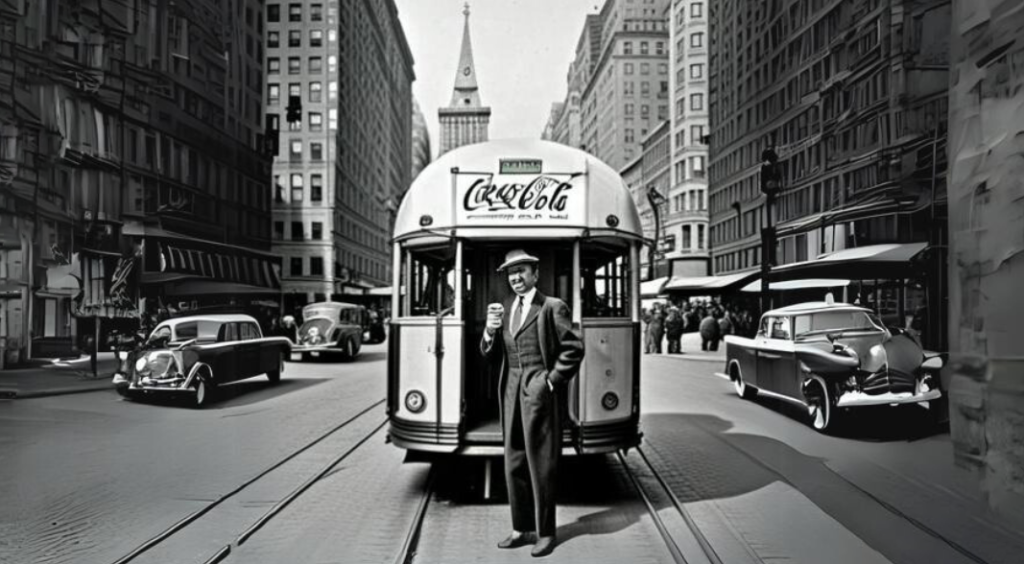
One of the world’s most iconic brands, has a long history of using transit media to enhance its brand awareness and reach a wider audience. In the 1920s, Coca-Cola was already a well-established brand, but the company recognized the potential of mass media to further strengthen its presence
Targeting a Diverse Audience
One of the remarkable benefits of transit media is its ability to reach a diverse audience. Commuters from various demographic backgrounds, professions, and interests regularly rely on public transportation like cars, metro trains, and autos. This diverse mix offers brands an ideal platform to target multiple customer segments simultaneously, broadening their customer base and maximizing their marketing efforts.
Let us know about the brand positioning of khiladi.com. khiladi.com, an emerging online betting app, embarked on a strategic car branding. This kind of campaign is mainly for enhancing its brand visibility across India. By Utilizing BrandOnWheelz car the campaign targeted 17,000 cabs in 11 cities and executed within a span of 30 days.
The Khiladi.com car branding campaign achieved a remarkable reach by branding 17,000 cabs all over India. This branding enabled the brand message to reach a vast audience, both pedestrians and commuters.
This campaign engendered a significant number of impressions, with a daily average of 68,00,00,000 and a monthly total of 20,40,00,00,000 which helps a lot for brand positioning of Khiladi.com because this is an indelible growth of a brand in the short span. By leveraging car branding nationwide, khiladi.com reached a wide audience and increased brand awareness in India.
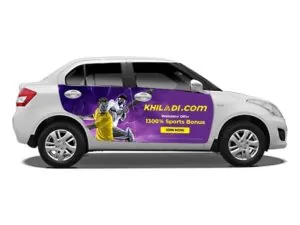
In diverse cities and transportation systems, khiladi.com often ran transit media campaigns, ensuring that non-Indians also received brand messages while seeing the cabs in the airport. The approach was particularly effective for immigrant communities and tourists.
Leveraging Transit Media for Effective Brand Positioning
Aligning Brand Message with Transit Environments
To effectively leverage transit media for brand positioning, it is crucial to align your brand message with the transit environment. Understanding the mindset of commuters and the specific challenges they face during their journey allows you to tailor your message to resonate with their needs. By addressing their pain points or offering solutions, your brand can position itself as an ally, enhancing the overall customer experience.
Utilizing Eye-Catching Designs and Visuals
Transit environments are filled with distractions, making it essential to create visually striking designs that capture the attention of commuters. Invest in creative visuals that are both aesthetically pleasing and informative, ensuring your brand stands out amidst the surrounding noise. Bold colors, unique graphics, and innovative design elements can leave a lasting impression and increase the likelihood of engagement with your brand.
Integrating Brand Personality into Transit Media
Transit media offers an opportunity to infuse your brand’s personality into the campaigns. By maintaining consistency with your brand’s tone, style, and messaging, you can create a cohesive experience for consumers. Building an emotional connection through your campaigns helps to humanize your brand and fosters a sense of relatability, ultimately strengthening your brand positioning.
Transit Media Strategies for Successful Brand Positioning

Utilizing Transit Media in Strategic Locations and Routes
To optimize your brand’s positioning, it is essential to strategically select locations and routes for your transit media campaigns. Conduct comprehensive research to identify high-traffic areas and routes that align with your target audience. By placing your ads in areas where your target customers are most likely to encounter them, you can maximize exposure and increase the chances of conversion.
Leveraging Data and Analytics for Optimized Targeting
In the age of digitalization, data and analytics play a critical role in effective brand positioning. Leverage the power of data to gain insights into consumer behaviour and preferences. Analyzing demographic data, commuting patterns, and customer engagement metrics allows you to refine your transit media strategy and target specific audience segments. This optimization leads to better results and a more impactful brand positioning.
Case Studies: Brands Leveraging Transit Media for Positioning
shunya, an iconic brand known for its powerful marketing campaigns, successfully harnessed the potential of transit media. By strategically placing eye-catching cab branding and metro branding in major cities in India, they ensured their brand remained top of mind among millions of commuters. The continuous exposure in transit environments enhanced their brand positioning and reinforced their status as a global leader in the beverage industry.
Case Study 1: Shunya and Their Transit Media Success Story
shunya, an iconic brand known for its powerful marketing campaigns, successfully harnessed the potential of transit media. By strategically placing eye-catching cab branding and metro branding in major cities in India, they ensured their brand remained top of mind among millions of commuters. The continuous exposure in transit environments enhanced their brand positioning and reinforced their status as a global leader in the beverage industry.
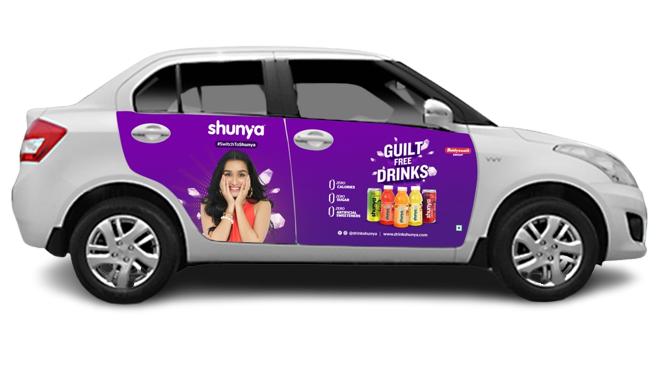
Case Study 2: How Britannia Revolutionized Their Brand Image with Transit Media
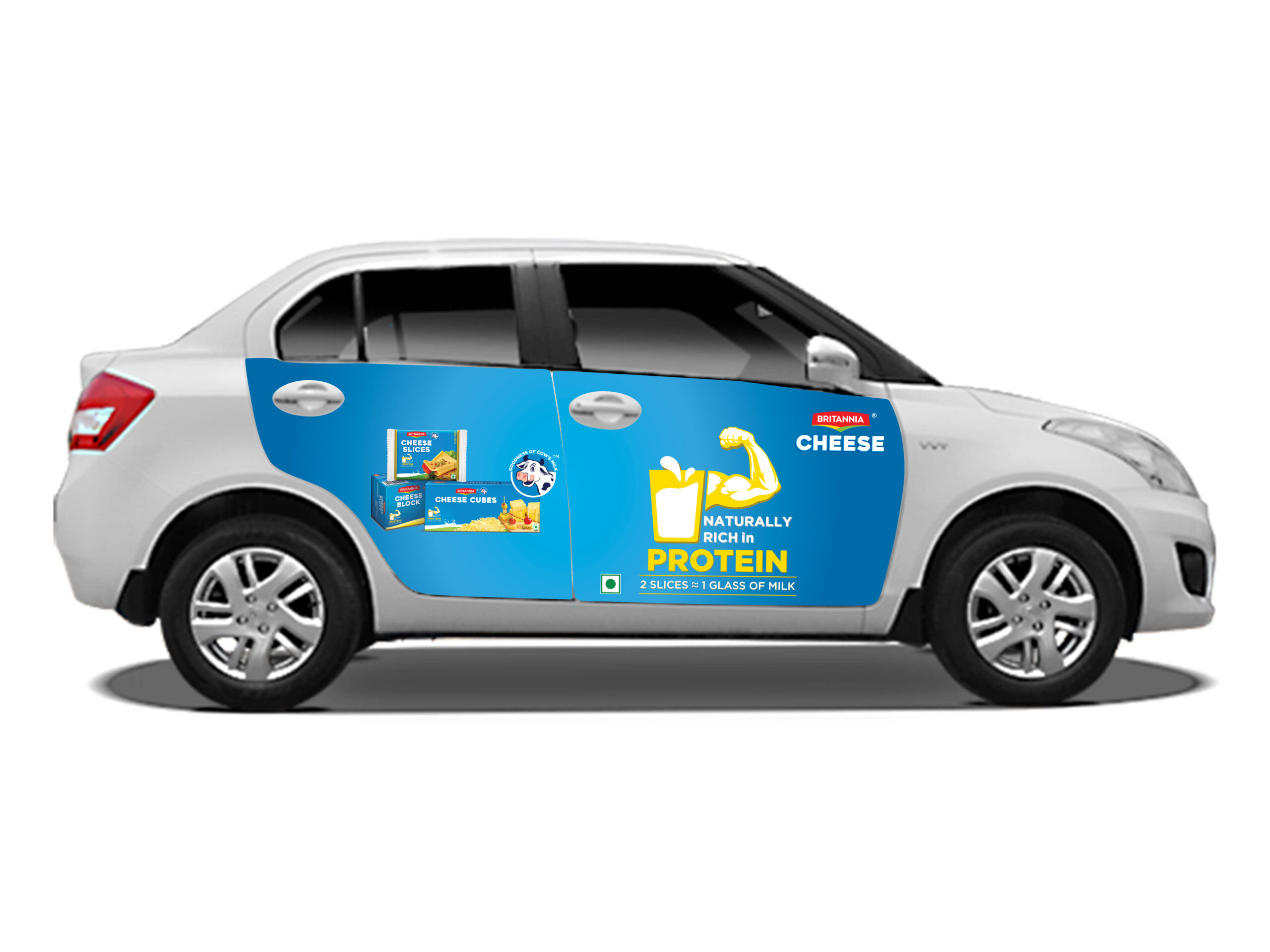
Britannia, renowned for its innovative approach to marketing, revolutionized its brand image through transit media. By utilizing interactive cab branding, and auto branding done by Brandonwheelz, they engaged commuters with clever games and challenges centered around their famous cookie. This interactive and immersive experience not only solidified their existing audience’s loyalty but also attracted new consumers, elevating their brand positioning to new heights.
Challenges of Transit Media and How to Overcome Them
Budget Considerations and Cost-Effectiveness
One of the challenges brands may face when considering transit media is budget limitations. Creating and executing high-quality transit media campaigns requires investment. However, with careful planning, research, and negotiation, brands can find cost-effective solutions that maximize their return on investment. Prioritizing highly-trafficked areas and utilizing targeted placements can help optimize budget allocation and enhance cost-effectiveness.
Maintaining Consistency Across Multiple Transit Platforms
As brands expand their transit media efforts across multiple platforms, maintaining consistency becomes a challenge. It is essential to develop clear brand guidelines and communication strategies that enable consistent messaging and design elements. Regular audits and collaboration with transit media partners can help ensure brand integrity across all touchpoints, reinforcing the brand positioning.
Measuring the Impact of Transit Media Campaigns
Measuring the impact of transit media campaigns can be challenging due to the inherent nature of public transportation environments. However, brands can leverage various metrics and tools to measure their success. Online surveys, customer feedback, website analytics, and promo codes specific to transit media campaigns are some ways to gauge the effectiveness and ROI of your transit media efforts.
The Brandon wheelz is one of the top most transit media advertising agency in India which has the experts to monitor the brand positioning.
The Future of Transit Media in Brand Positioning
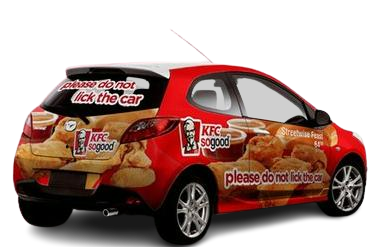
Technological Advancements Shaping Transit Media
The future of transit media lies in the integration of cutting-edge technology into advertising platforms. Augmented reality (AR), virtual reality (VR), and interactive displays are increasingly being explored to create immersive and engaging experiences for commuters. Embracing these technological advancements opens up new possibilities and enhances the potential for brands to captivate their target audience, revolutionizing brand positioning in transit environments.
Innovative Possibilities for Brand Integration
Transit media is evolving beyond traditional ad placements. Brands are now exploring opportunities for deeper brand integration within transit systems. Collaborations with transportation authorities for branded partnerships, interactive touchpoints, and experiential installations are just a few examples of how brands can create memorable and impactful experiences, further cementing their brand positioning.
Predictions for the Future of Transit Media
As the world becomes increasingly connected and urbanized, the future of transit media looks promising. Personalized and location-based targeting, enhanced interactivity, and seamless integration with mobile platforms are expected to become standard practices. The convergence of transit media with emerging technologies will continue to revolutionize brand positioning, providing brands with even greater opportunities to connect with their target audience.
Summary
Transit media is an undeniable game-changer in brand positioning. Its ability to increase brand visibility, target diverse audiences, enhance credibility, and expand reach opens up endless possibilities for brands to leave a lasting impression. By aligning brand messages, utilizing eye-catching designs, and integrating brand personality into campaigns, brands can successfully position themselves in the hearts and minds of consumers. Strategic planning, syncing with other marketing efforts, and leveraging data analytics optimize the effectiveness of transit media. Overcoming challenges, measuring impact, and embracing future technological advancements further solidify transit media’s transformative power. Embrace this ultimate game-changer and elevate your brand positioning to new heights.
Frequently Asked Questions (FAQs)
- Transit media is suitable for a wide range of brands. However, it is essential to consider your target audience and whether they are likely to commute using public transportation. Brands targeting specific demographics or needing local visibility often find transit media particularly effective.
- Measuring the ROI of transit media campaigns involves tracking relevant metrics such as website traffic, customer engagement, lead generation, and conversions. Utilizing unique promo codes or landing pages specific to transit media campaigns can also help in measuring its impact.
- The effectiveness of transit media platforms depends on your target audience, geographic location, and campaign goals. Cab branding, Tata Ace branding, and metro train branding in transit hubs generally offer high visibility and engagement potential.
Yes, transit media can be effective in targeting specific demographics. By strategically selecting transit routes and locations frequented by your target audience, you can enhance the likelihood of reaching and engaging with your desired demographic



